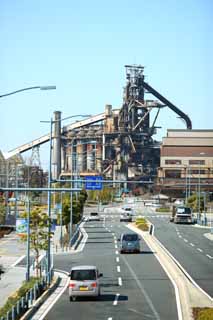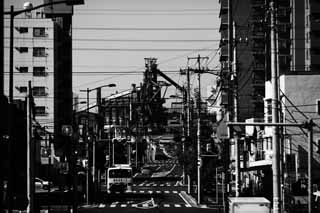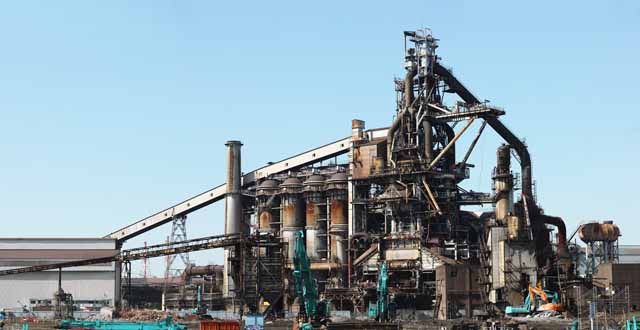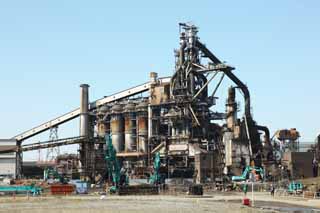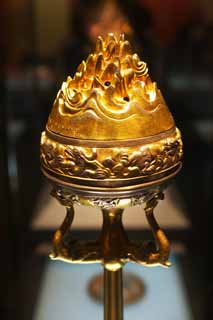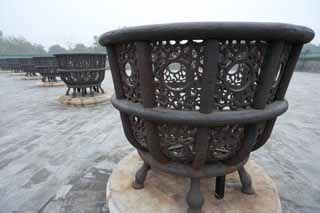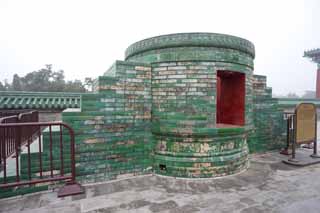Images can be modified and be used for commercial purposes without fee under the license.
Next keyword "a cell"
Click the thumbnail to look.
Keyword Search in this Site
You can search the image by entering the keyword in the following box.

Custom Search
No.7709 The town of the blast furnace
| It is the dismantling spot of the fifth JFE East Japan ironworks Chiba District blast furnace. I invited time of the dismantling to the blast furnace which I continued producing iron of enormous quantity and carried Japanese high economic growth on since I made field firing in (1965) in 1965. The huge structure that innumerable pipes were set up finishes a role in the noise now. Thank you. | |
| Camera: | Canon EOS-1Ds Mark III , EF 135mm F2L |
|---|---|
| Location: | Japan / Chiba Prefecture |
| Size: | 3744 x 5616Pixels |
No.7708 The town of the blast furnace
| It is the dismantling spot of the fifth JFE East Japan ironworks Chiba District blast furnace. I invited time of the dismantling to the blast furnace which I continued producing iron of enormous quantity and carried Japanese high economic growth on since I made field firing in (1965) in 1965. The huge structure that innumerable pipes were set up finishes a role in the noise now. Thank you. | |
| Camera: | Canon EOS-1Ds Mark III , EF 135mm F2L |
|---|---|
| Location: | Japan / Chiba Prefecture |
| Size: | 5616 x 3744Pixels |
No.6981 Dismantling a blast furnace
| Dismantling the number 5 JFE ironworks blast furnace in the Chiba District. The blast furnace continued to produce large quantities of iron, supporting Japan's economic growth since it began operating in February 1951. It was the first modern integrated steelworks in Japan in the postwar period. Now this huge structure with thousands of pipes, conveyor belts, and other machinery must be removed by wrecking crews. | |
| Camera: | Canon EOS-1Ds Mark III , EF 135mm F2L |
|---|---|
| Location: | Japan / Chiba Prefecture |
| Size: | 12116 x 6247Pixels |
No.6980 Dismantling a blast furnace
| Dismantling the number 5 JFE ironworks blast furnace in the Chiba District. The blast furnace continued to produce large quantities of iron, supporting Japan's economic growth since it began operating in February 1951. It was the first modern integrated steelworks in Japan in the postwar period. Now this huge structure with thousands of pipes, conveyor belts, and other machinery must be removed by wrecking crews. | |
| Camera: | Canon EOS-1Ds Mark II , SIGMA MACRO 70mm F2.8 EX DG |
|---|---|
| Location: | Japan / Chiba Prefecture |
| Size: | 5616 x 3744Pixels |
No.5512 Bronze Bamboo-joint-shaped Censer with Gilded Gold and Silver
| Shaanxi Provincial History Museum of Western Han dynasty there was an incense burner, pure gold in gold and silver bamboo joint Kaoru reactor. 206 BC to AD 8 years of age. Emperor Wu of the Han sister used to be. 58 cm in height, which is part of the head. | |
| Camera: | Canon EOS-1Ds Mark III , SIGMA MACRO 70mm F2.8 EX DG |
|---|---|
| Location: | China / Xi'an |
| Size: | 3744 x 5616Pixels |
No.5164 Temple of Heaven reactors
| China's world heritage, the Temple of Heaven was buttocks reactor. In ancient China, this kind of reactor, gather and burn it. buttocks the emperor to pray for the New Year for the 1420 building. Diameter of 32 m, height of 38 m of living of China's largest altar. The roof is three tiers lapis lazuli, nails and a single beam construction system is famous for its use. | |
| World Heritage | Temple of Heaven: an Imperial Sacrificial Altar in Beijing |
|---|---|
| Camera: | Canon EOS-1Ds Mark II , Distagon 21mm F2,8 |
| Location: | China / Beijing |
| Size: | 4992 x 3328Pixels |
No.5163 The Temple of Heaven reactor
| China's world heritage, the Temple of Heaven was reactor buttocks. In ancient China, this kind of furnace smoke to gather up and burn dedicated to the heavens. on New Year's buttocks to the emperor to pray for the building, 1420. Diameter of 32 m, height of 38 m of living of China's largest altar. The roof is three tiers lapis lazuli, nails and a single beam construction system is famous for its use. | |
| World Heritage | Temple of Heaven: an Imperial Sacrificial Altar in Beijing |
|---|---|
| Camera: | Canon EOS-1Ds Mark II , Distagon 21mm F2,8 |
| Location: | China / Beijing |
| Size: | 4992 x 3328Pixels |
